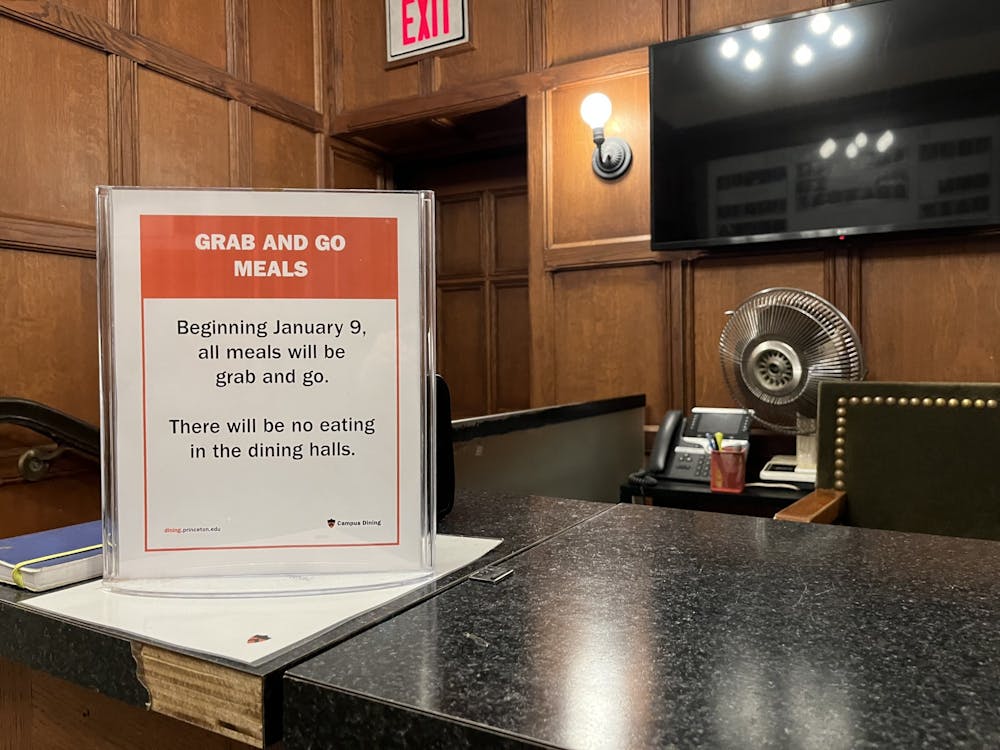Students are returning to a changed campus as the infectious omicron variant sends case levels to new heights. Princeton has responded to the changing circumstances by limiting social gatherings, changing dining to grab-and-go, and constraining student events. At the same time, the University has shortened the isolation period and ended its policy of contact tracing all confirmed positive cases, focusing in on only those groups at highest risk. Administrators have also stressed that they remain committed to offering in-person classes.
We asked columnists for their Reactions to the University’s response.
The University’s commitment to keeping in-person classes is admirable, with one caveat.
By Ashley Olenkiewicz, Columnist
My first days back home for winter break were filled with anxiety as headline after headline alerted me of yet another university announcing their plans to begin the spring semester online. Princeton students’ unceremonious and premature departure from campus only a week prior was unsettling, but learning that we might soon be reliving the spring of 2020 filled me with dread. Virtual schooling is miserable.
I was relieved to learn that our return to campus would be postponed by only a few days, rather than weeks or months. The University’s commitment to keeping in-person classes is admirable, especially because it differs from the choices that other top universities have made. We should not make knee-jerk decisions in response to COVID-19, especially implementing restrictions that were only acceptable under the cloud of uncertainty that marked the early pandemic.
It is no longer the spring of 2020. COVID-19 is no longer a scientific mystery, and we are now equipped with three doses of the vaccine and a plethora of KN95 masks to ward off infection. While omicron is far more transmissible than past variants, research has shown that our age group, when fully vaccinated, will usually only experience mild symptoms (Centers for Disease Control and Prevention (CDC) data shows that for fully vaccinated 18–29 year olds, the death rate was most recently 0.01 percent).
There is one caveat, however. At-risk students deserve the option to join class via Zoom. Likewise, older or otherwise at-risk faculty deserve to be offered paid leave or hazard pay if they choose to work. This simple step would allow us to preserve the benefits of in-person education while keeping all members of our community safe.

I applaud Princeton for staying committed to in-person instruction, as vaccines, masks, and social distancing allow the majority of us to be here safely, as long as the concerns of at-risk Princetonians are addressed to ensure the safety of everyone.
Ashley Olenkiewicz is a first-year from Porter, Texas. She can be reached at ao8250@princeton.edu.
The new grab-and-go policy is a winner
By Windsor Nguyễn, Columnist

For as long as Princeton has had COVID-19 restrictions, the lack of attention towards the dining halls has been the University’s most puzzling COVID-19 policy. In the spring of 2020, campus was shut down due to concerns about COVID-19 transmission. In-person classes ranging from lectures of 100 students to precepts of 20 students to seminars of even fewer were deemed too dangerous to take place, yet dining halls remained open. At the end of last semester, various social events were canceled and meetings went virtual, yet dining halls operated at full capacity with students maskless once sitting down, socializing in a pathogen breeding ground.
Fortunately, faculty and staff have worked hard to ensure that this spring semester will be a success through measures such as hybridizing many activities. However, it’s clear that the most important preventative measure — especially in the early days of the semester — will be the grab-and-go dining system. This effectively addresses one of the biggest risks of COVID-19 transmission on campus.
Although grab-and-go isn’t perfect, notably causing an increase in improperly disposed waste, the benefit of limiting viral transmission far outweighs any potential disadvantages. As we kick off the spring semester, grab-and-go will keep cases at a minimum while altering students' personal lives as little as possible.
Windsor Nguyễn is a first-year student from Appleton, Wis. He can be reached at mn4560@princeton.edu or @windsor.nguyen on Instagram.
Princeton must expand isolation housing as soon as possible
By Ndeye Thioubou, Columnist
The radically changed isolation protocol came all at once. On Jan. 19, Vice President for Campus Life W. Rochelle Calhoun and Dean of the College Jill Dolan announced that with isolation housing space nearing capacity, students with singles might have to begin isolating in their rooms, even if they share bathrooms. Students in isolation housing would begin sharing rooms, and students living in doubles would be prioritized for access to isolation housing. On Sunday, Jan. 23, a day before we were scheduled to begin spring semester classes, the new isolation protocol went into effect.
The University clarified that if one roommate tests positive and another tests negative for COVID-19, they will reach out and make arrangements to move the roommate who tests negative. There remains no transparency about where the roommate who tests negative will be housed. The University calls this an “unlikely event,” but unless roommates are spending a lot of time together every day and share similar schedules, it may be more realistic than Princeton imagines.
Additionally, the University noted that COVID-positive students isolating in their dorm will be permitted to take off their masks in bathrooms to brush their teeth and shower, and may pick up food while masked. Although the University does say that these students will be provided with disinfectant wipes, this does not necessarily mitigate the spread of COVID-19 because the virus is airborne. A COVID-positive student brushing their teeth unmasked could easily spread the virus to a student without COVID-19 next to them.
COVID-positive students who will be unmasked in bathrooms break a key rule of isolation – no contact with people who are not infected. The modified isolation (if it can even be called that) will inevitably lead to further spread of COVID among the student population.
The University needs to figure out how to expand COVID isolation housing, immediately. Students should not have to worry about whether people they share a bathroom with have COVID-19 or not, nor should they have to contend with the University’s haphazard relocation plans.
Two days into the semester, isolation housing utilization was already at 101 percent. The ability of the University to expand isolation housing will directly influence the success of this semester, whether it will be defined by COVID-19, or its spread can be contained so that the vast majority of students are able to enjoy a semester as close to normal as possible.
Ndeye Thioubou is a first-year from The Bronx, N.Y. She can be reached at nthioubou@princeton.edu.
Can we adapt to an oscillating pandemic?
By Rohit Narayanan, Community Opinion Editor
Princeton University semesters always seem to start in the middle of a COVID wave: the summer wave of 2020, the winter COVID-19 surge of 2021, the delta wave, and now the omicron wave. Our semesters start when the University is being pressured to slow the spread, yet we spend most of the semester during a period of comparatively lower risk.
Unless we believe that the omicron wave will be the last (which it could be, but it’s not a sure bet), we have to get a lot faster at reacting to the pandemic. It may be appropriate at the moment to maintain stricter measures, and it may even be appropriate to move some activities online. But when omicron declines, as it seems to be trending, we have to remove the measures, and we have to do it fast.
The University has a pretty terrible record at acting quickly — often preferring to keep the beginning of semester status quo in place. The fall semester of 2020 was moved completely online due to the summer wave, which had declined significantly by the time classes started. Vaccinations were widely available by the end of Spring 2021 and warm weather made meeting outside possible, but no serious effort was made to start in-person classes. In the fall, the delta-inspired mask mandate survived week after week of low COVID-19 cases as the University kept delaying lifting it until cases rose again.
We live in the world of the oscillating pandemic. Restrictions — even minor ones — are deeply disruptive to the student body, especially our once-vibrant extracurricular scene. It’s not wrong for the University to take the pandemic seriously, and to act accordingly when cases are high. But we must move quickly to normalize our campus when we can.
Rohit Narayanan is a sophomore from McLean, Va. He can be reached at rohitan@princeton.edu.








